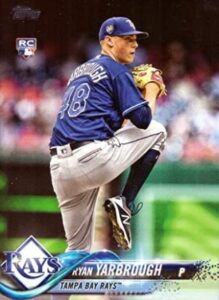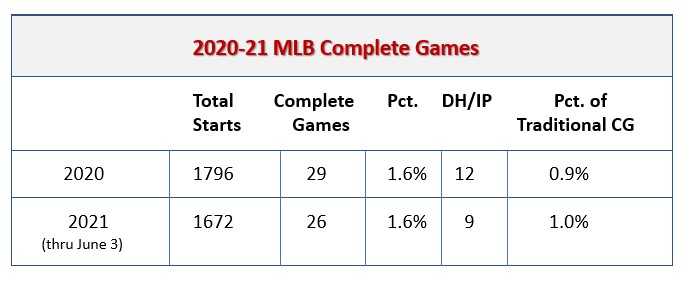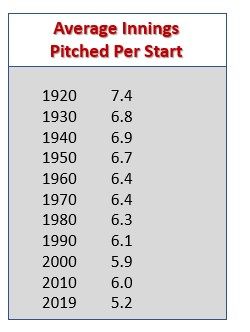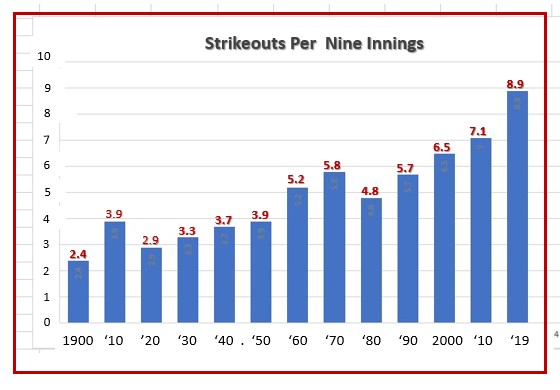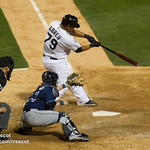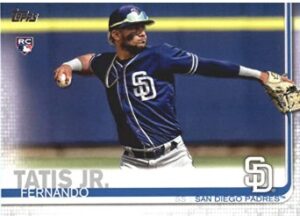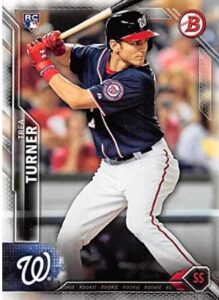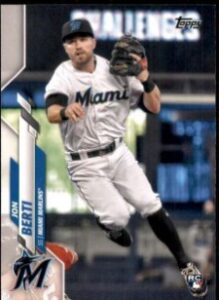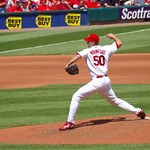MLB’s 2020 regular-season has come to an end and it’s time for Baseball Roundtable’s traditional monthly wrap up:
- A look at the previous (in this case, final) month of the season, and the stories and stats that caught BBRT’s eye;
- September and final won-lost records;
- BBRT’s Players and Pitchers of the month; and
- BBRT’s “Trot Index”.
In this post, I’ll also share a few thoughts/predictions on the post-season. Before we get into the details, here are a few events that helped shape September 2020 (more on these and other September “happenings” in the “Highlights” section).
- Six National Leaguers shared the September lead in triples (2) – two were catchers (D-backs’ Daulton Varsho & Giants’ Joey Bart).
- Everyone speculated the Astros might become HBP targets this season. Twenty-three Astros were plunked – slightly below the MLB average of 27. (The Cubbies “felt” 52 plunkings.)
- Fly Fishing. Mike Trout topped Tim Salmon‘s Angels’ franchise long-ball record.
- The Rays put the first all-lefty MLB lineup on the field.
- Alex Mills threw 2020’s second no-hitter – in his first MLB complete game.
- Indians’ 3B Jose Ramirez led MLB (qualifiers) in September slugging percentage at .841 – 91 percentage points up on the NL leader and 174 points up on second-best in the NL.
- Billy Hamilton made it home the easy way (home run) and the hard way (steal of home) … in the same game.
- The Brewers turned MLB’s first 2020 triple play … on the final day of the regular season.
- DJ LeMahieu became the first player to win a batting championship in both the NL and AL.
- The top seven pitchers (and 12 of the top 15) in September strikeouts were National Leaguers.
- Three pitchers were trusted with an MLB-high six starts in September … they went a combined 3-7, 4.92.
Again more on these and other September “stories” in the highlights section. Before we get deeper into September and year-end stats, let’s look at BBRT’s Players and Pitchers of the Month.
—–PLAYERS AND PITCHERS OF THE MONTH (SEPTEMBER)—–
NATIONAL LEAGUE
Player of the Month – Marcell Ozuna, OF/DH. Braves
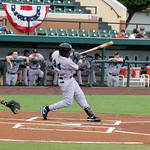
Photo by hueytaxi 
Marcell Ozuna was a dominant force for the Braves in September – and still barely edged out teammate Freddie Freeman for this honor. Looking at MLB stats for the month, Ozuna’s .394 average led MLB (Freeman was second at .375); Ozuna’s 33 RBI also led MLB (Freeman was second at 32). Ozuna’s ten home runs were second only to teammate Adam Duvall’s eleven and Ozuna’s 41 hits led MLB (Freeman was third at 36). In addition, Ozuna tied with Freeman for the NL’s top slugging percentage at .750. For the month, Ozuna had a hit in 23 of 26 games -including ten multi-hit games. He opened the month (September 1) with a three-homer, six-RBI performance against the Red Sox.
Honorable Mentions: As noted above Freddie Freeman was in the running. In fact, he had a couple of things going for him: he spent more time on the field (rather than DH) than Ozuna; he struck out only 14 times to Ozuna’s 25. Ultimately, the margin was razor thing between Freeman and Ozuna. Also have to put in a good word for the Phillies’ 24-year-old rookie 3B Alec Bohm, whose 40 September hits were second only to Ozuna’s 41. Bohm hit .367 for the month, with three home runs,16 RBI and 17 runs scored.
Pitcher of the Month – Corbin Burnes, RHP, Brewers
 What can you say about Corbin Burnes? He was pretty much lights out in September until suffering an oblique strain that knocked him out of his last start. To that point in the month, he was 3-0, with a tiny 0.38 earned run average in four starts. Even with that last start hiccup, Burnes finished with a September record of 3-1, with a 1.32 earned run average (second in the NL only to the Reds’ Trevor Bauer’s 1.29) and 42 strikeouts (only seven walks) in 27 1/3 innings. His 13.8 strikeouts per nine frames in September trailed only Jason deGrom and Shane Bieber in MLB – pretty good company.
What can you say about Corbin Burnes? He was pretty much lights out in September until suffering an oblique strain that knocked him out of his last start. To that point in the month, he was 3-0, with a tiny 0.38 earned run average in four starts. Even with that last start hiccup, Burnes finished with a September record of 3-1, with a 1.32 earned run average (second in the NL only to the Reds’ Trevor Bauer’s 1.29) and 42 strikeouts (only seven walks) in 27 1/3 innings. His 13.8 strikeouts per nine frames in September trailed only Jason deGrom and Shane Bieber in MLB – pretty good company.
Corbin Burnes has had an up-and-down MLB run. Called up to the Brewers in July of 2018. He appeared in 30 games for Milwaukee that season (all in relief) and went 7-0, 2.61. Then in 2019, he appeared in 32 games for the Brew Crew (four starts) and went 1-5, 8.82. This season, he appeared in 12 contests (nine starts) and went 4-1, 2.11.
Honorable Mentions: The Reds’ Trevor Bauer also deserves recognition, despite going just 2-2 for the month. Bauer pitched to a 1.29 earned run average and fanned 46 batters (second in MLB), with just six walks in 35 innings. Luis Castillo, also of the Red gets shout out for picking up four wins in five September starts (the only MLB pitcher with four September victories), with a 2.20 earned run average, one complete game and 37 strikeouts in 32 2/3 innings. Like Burnes, Castillo is a surprise in this competition. Going into the month, he was 0-5, with 4.10 earned run average. Finally, there is hard-luck Padre Dinelson Lamet, who started five times, produced a 1.76 ERA and fanned 42 batters in 27 innings, but got only one win and four no-decisions (despite the fact that San Diego won all five of his September starts.
AMERICAN LEAGUE
Player of the Month – Jose Ramirez, Indians, 3B
 Jose Ramirez’ hit a robust .366 in September (second in the AL), with an AL-topping (and MLB’s second-best) ten home runs. Ramirez drove in 24 runs (fourth in the AL) and scored 18. Ramirez also swiped two bases and had more walks (11) than strikeouts (10). Nineteen of Ramirez’ 30 hits went for extra bases and His .841 slugging percentage far outdistanced the pack (second best in MLB was .750).
Jose Ramirez’ hit a robust .366 in September (second in the AL), with an AL-topping (and MLB’s second-best) ten home runs. Ramirez drove in 24 runs (fourth in the AL) and scored 18. Ramirez also swiped two bases and had more walks (11) than strikeouts (10). Nineteen of Ramirez’ 30 hits went for extra bases and His .841 slugging percentage far outdistanced the pack (second best in MLB was .750).
Honorable Mentions: Ramirez inched out White Sox ‘1B Jose Abreu, who hit .320, drove in 28 September runs (first in the AL); scored 19 times (fifth in the AL); and popped seven home runs. Abreu’s 29 September hits were third in the AL and seventh in MLB. Blue Jays’ outfielder Lourdes Gurriel, Jr. was also in the chase, after hitting an AL-best .368 in September, with seven home runs, 16 RBI and 19 runs scored.
Pitcher of the Month – Tie: Gerrit Cole, Yankees & Chris Bassitt, A’s
 Gerrit Cole came through for the Yankees in the stretch – going 3-1, giving up just three earned runs in 27 innings pitched (1.00 September ERA.) Cole’s 34 strikeouts were fourth-best in the AL – and he walked just five. His September performance included a 6-0, complete game, two-hit shutout over the Orioles (seven innings). Chris Bassitt of the A’s went 3-0, 0.34 and gave up just one run in 26 2/3 September innings. (four starts). Bassitt fanned 25 batters (five walks) in 26 2/3 innings. This was really a toss=up for me.
Gerrit Cole came through for the Yankees in the stretch – going 3-1, giving up just three earned runs in 27 innings pitched (1.00 September ERA.) Cole’s 34 strikeouts were fourth-best in the AL – and he walked just five. His September performance included a 6-0, complete game, two-hit shutout over the Orioles (seven innings). Chris Bassitt of the A’s went 3-0, 0.34 and gave up just one run in 26 2/3 September innings. (four starts). Bassitt fanned 25 batters (five walks) in 26 2/3 innings. This was really a toss=up for me.
Honorable Mentions: Can’t leave out the White Sox’ Dallas Keuchel, who may have only gotten one win in four starts, but pitched to a 0.45 earned run average. We should also recognize Indians’ closer Brad Hand, who picked up six September saves (in six opportunities) and two wins in eleven appearances, while putting up a 0.79 ERA and fanning 16 in 11 1/3 innings.
Surprise Player of the Month – Jared Walsh, Angels, 1B
Jared Walsh came into September 41 career MLB games on his resume – with a .173 average, one home run and five RBI. Further, in July and August of this season, he was zero-for-thirteen in ten games. Then came September. Walsh got in 22 games and went 29-for-86 (.337), with four doubles, two triples, nine home runs and 26 RBI. Drafted in 39th round of the 2015 MLB draft (out of the Universality of Georgia), Walsh has been a two-way player. In 2019, he pitched in five games for the Halos, putting up a 1.80 earned run average with five strikeouts in five innings.
______________________________________________________
TROT INDEX … A REGULAR BBRT FEATURE
For 2020, 37.3 percent of MLB’s 66,506 2020 plate appearances ended in a trot (back to the dugout, around the bases, to first base). We’re talking about strikeouts, home runs, walks, hit by pitch and catcher’s interference – all outcomes that are, basically, devoid of action on the base paths or in the field. Here’s the breakout: strikeouts (23.4%); walks (9.1%); home runs (3.4%); HBP (1.2%); catcher’s interference (less than 1%). Personally, I’d like more action in the field of play.
The 37.4 percent figure is up from 2019’s (full season) 36.2 percent and 2018’s 34.8 percent Trot Index.
_________________________________________________
You’ll find full standings and stats near the end of this post, but here are your Round One opponents and seeding. Side note: I see this as fine for this strange season (it did add interest), but I’m not a fan for the future. This year, for example; the Astros and Brewers made “the tournament” with sub-.500 records. I prefer fewer teams and recognition (again next season) of the marathon that is an MLB season.
Some minor predictions for Round One. Predictions on late rounds coming soon. Wanted to get this out before tomorrow’s games.
- Rays over Blue Jays. Rays’ pitching slows Jays’ offense and not vice versa.
- Yankees over Indians. Yankees offense and Gerrit Cole should edge the Tribe.
- Twins over Astros. Twins 24-7 at home. Astros 9-23 on the road. Enough said.
- White Sox over A’s. Pretty even match up, but White Sox offense should prevail.
- Dodgers over Brewers. Brewers seem over matched to me.
- Padres over Cardinals. Really a toss up, but home field helps and it feels like a Padres year to me.
- Cubs over Marlins. Two run-of-the-mill offenses, but Cubs have a pitching edge.
- Reds over Braves. This is all about Reds pitching versus Braves offense. Betting that Bauer, Castillo and Gray can slow down Acuna, Ozuna and Freeman. This is my long-shot prediction.
___________________________________________
Among the hottest teams in September were the Dodgers (17-7), Twins (16-8), Padres (15-8) and Reds (16-9) … and they illustrated the value of pitching. All four squads registered among the six lowest September earned run averages. Notably, the 17-7 Dodgers also put up some solid offense. Their 145 September runs were third among the 30 MLB teams. LA kind of had the best of both worlds. Meanwhile the Padres were 16th in scoring, the Twins 18th and the Reds 25th. Clearly, pitching was of premium value. On the other end of the mound spectrum, , the Tigers (7-19) and Rockies (9-19) boasting two of the three worst September records, also recorded two of the three worst September ERA’s.
Looking for exceptions to prove the rule? The Blue Jays had September’s second worst ERA at 5.85, but overcame that with solid offense (fourth-most runs scored) to put up a 14-13 record and the Braves led MLB in September runs scored (173), helping overcome a 4.64 ERA (11th worst) to produce a 15-11 record.
————-September 2020 Team Statistical Leaders August——————-
RUNS SCORED
National League – Braves (173); Dodgers (145); Phillies (138)
American League – Yankees (153; Blue Jays (144); Red Sox (130)
The Pirates scored the fewest runs in September (91); while the Tigers were at the bottom of the American league at 97. The only other team to score fewer than 100 September runs was the Mariners (98). For a bit of comparison, the Braves averaged 6.7 runs per game for the month, the Pirates averaged 3.3.
BATTING AVERAGE
National League – Mets (.284); Giants (.279);Braves (.277)
American League – Red Sox (.277); Angels (.270); Blue Jays (.264)
The Reds averaged an MLB-low .206 for the month. The Mariners had the lowest average in the AL at .216.
ON-BASE PERCENTAGE
National League – Braves (.372); Giants (.355); Mets (.349)
American League – Yankees (.348); Red Sox (.345); Angels (.345)
HOME RUNS
National League – Braves (55); Dodgers (50); Mets (43)
American League – Twins (42); Yankees (41); Red Sox (38)
Doing a bit to factor out the differences in games (and innings) played, the Dodgers had the most powerful “at bats per home run” ratio at 16.44 The fewest at bats per long ball in the American League went to the Twins at 18.43.
WALKS
National League – Braves (126); Phillies (121); Reds (105)
American League – Yankees (128); A’s (98); Blue Jays (91)
The Braves’ had the highest on-base percentage in August (.372). The Yankees led the AL at .348.
STOLEN BASES
National League – Padres (24); Nationals (24); Rockies (21)
American League – Rays (31); Royals (25); Red Sox (20); Rangers (20)
The Mets stole the fewest bases during September – just four in nine attempts. (The Rays were also “caught stealing” five times during the month, but were successful 31 times.)
BATTER’S STRIKEOUTS
National League – Cardinals (282); Marlins (257); Phillies (254)
American League – Rays (275); Rangers (268); Tigers (253)
EARNED RUN AVERAGE
National League – Padres (3.15); Reds (3.37); Cubs (3.38)
American League – Twins (3.28); Rays (3.32); Indians (3.89)
The highest ERA for September belonged to the Rockies at 5.42. In the American League that “high” (low?) mark went to the Blue Jays at 5.85. Overall, eight of the 30 teams had ERAs north of 5.00.
STRIKEOUTS
National League – Phillies (268); Cardinals (268); Brewers (261)
American League – Indians (261); Yankees (245); Astros (238)
Whiff-Masters
Six teams fanned at least ten batters per nine frames in September: Brewers (10.78); Padres (10.64); Indians (10.58); Reds (10.45); Mets (10.29); Phillies (10.01).
WALKS (fewest)
National League – Dodgers (47); Padres (58); Brewers (66)
American League – Rays (60); Twins (61); A’s (63)
The Dodgers’ staff showed the greatest control with 1.96 walks per nine innings in September, while the Rays were best in the AL at 2.58. The Blue Jays’ staff walked an MLB-high 4.67 batters per nine innings over September. The Dodgers, by the way, also led in strikeouts per walk at 4.55. The Indians led the junior circuit at 3.95.
SAVES
National League – Cardinals (8); Diamondbacks (7); Marlins (7)
American League – Blue Jays (9); Royals (8); Rays (8)
The Pirates had just two save (in nine save opportunities) for September. The only other teams successful in less than half their save opportunities were the Rangers (two-for-six);Tigers (four-for-nine); and Phillies (six-for-thirteen).
——-Individual Statistical Leaders September ———-
AVERAGE (minimum 75 at bats)
National League – Marcell Ozuna, Braves (.394); Freddie Freeman, Braves (.375); Jeff McNeil, Mets (.356)
American League – Lourdes Gurriel, Jr., Blue Jays (.368); Jose Ramirez, Indians (.366); Adalberto Mondesi, Royals (.356)
The lowest August average (minimum 75 at bats) belonged to the Cubs’ Kyle Schwarber at .130 (10-for-77). The AL’s lowest could be found across town – the White Sox’ Luis Robert at .136 (11-for-81).
HOME RUNS
National League – Adam Duvall, Braves (11); Marcell Ozuna, Braves (10); AJ Pollock, Dodgers (10)
American League – Jose Ramirez, Indians (10); George Springer, Astros (9); Jared Walsh, Angels (9); Luke Voit, Yankees (9)
No player had more at bats without a long ball in September than Rangers’ 2B Nick Solak (93).
RUNS BATTED IN
National League – Marcell Ozuna, Braves (33); Freddie Freeman, Braves (32); Chris Taylor, Dodgers (23); Trea Turner, Nationals (23)
American League – Jose Abreu, White Sox (28); Jared Walsh, Angels (26); Luke Voit, Yankees (26)
HITS
National League – Marcell Ozuna, Braves (41); Alec Bohm, Phillies (40); Freddie Freeman, Braves (36)
American League – DJ LeMahieu, Yankees (36); Lourdes Gurriel, Jr., Blue Jays (35); Will Castro, Tigers (34)
DOUBLES
National League – Freddie Freeman, Braves (12); Dominic Smith, Mets (9); Alex Dickerson, Giants (9)
American League – Eloy Jimenez, White Sox (9); Jose Ramirez, Indians (9); DJ LeMahieu, Yankees (9); Cavan Biggio, Blue Jays (9)
TRIPLES
National League – Daulton Varsho, D-backs (2); Ke’Bryan Hays, Pirates (2); Asdrubal Cabrera, Nationals (2); Trea Turner, Nationals (2); Joey Bart, Giants (2); Trevor Story, Rockies (2)
American League – Cedric Mullins, Orioles (3); Yoan Moncada, White Sox (3); nine with two
The Indians’ Jose Ramirez led MLB in September slugging percentage at a robust .841. Second, and sharing the NL lead were the Braves’ Freddie Freeman and Marcell Ozuna far behind at .750.
STOLEN BASES
National League – Trea Turner, Nationals (9); Trevor Story, Rockies (7); three with six
American League – Adalberto Mondesi, Royals (16); Manual Margot, Rays (8); Leody Taveras, Rangers (7); Jonathan Villar, Blue Jays (70)
Trea Turner stole the most September bases without being caught (9).
WALKS
National League – Juan Soto, Nationals (28); Christian Yelich, Brewers (26); Bryce Harper, Phillies (25)
American League – Aaron Hicks, Yankees(21); Cavan Biggio, Blue Jays (20); Mike Trout, Angels (18)
The Nationals’ Juan Soto had September’s highest on-base percentage (.533). No other player reached the .500 mark.
BATTER’S STRIKEOUTS
National League – Keston Hiura, Brewers (37); Christian Yelich, Brewers (36); Paul DeJong, Cardinals (36)
American League – Miguel Sano, Twins (39); Evan White, Mariners (37); Matt Olson, A’s (36); Joey Gallo, Rangers (36)
PITCHING VICTORIES
National League – Luis Castillo, Reds (4-1); nine with three
American League – 12 with three
The Nationals’ Patrick Corbin led MLB in September losses, going 0-5, 5.64 in five starts.
EARNED RUN AVERAGE (minimum 20 IP)
National League – Trevor Bauer, Reds (1.29); Corbin Burnes, Brewers (1.32); Kyle Hendricks, Cubs (1.45)
American League – Chris Bassitt, A’s (0.34); Dallas Keuchel, White Sox (0.45); Gerrit Cole, Yankees (1.00)
Eight pitchers with at least four September starts posted ERAs under 2.00. Of those, three notched just one win each: Dallas Keuchel, White Sox (1-0, 0.45); Dinelson Lamet, Padres (1-0, 1.76); Carlos Carrasco, Indians (1-1, 1.97).
STRIKEOUTS
National League – Aaron Nola, Phillies (48/35 1/3 IP); Trevor Bauer, Reds (46/35 IP); Jacob deGrom, Mets (46/27 IP)
American League – Shane Bieber, Indians (38/24 2/3 IP); Carlos Carrasco, Indians (37/32 IP); Framber Valdez, Astros (36/32 1/3 IP)
September’s leader in strikeouts per nine innings was the Mets’ Jacob deGrom at 15.33; followed by the Indians’ Shane Bieber (Indians) at 13,86.
INNINGS PITCHED
National League – Kyle Hendricks, Cubs (37 1/3); Aaron Nola, Phillies (35 1/3); Trevor Bauer, Reds (35)
American League – Zach Plesac, Indians (34 1/3); Jordan Lyles, Rangers (33 1/3); Lance Lynn Rangers (32 2/3)
The Phillies’ Aaron Nola was the only pitcher with two complete games in September. He also led MLB with six starts (tied with Kyle Freeland of the Rockies and Jon Lester of the Cubs). Nola went 2-3, 3.57.
SAVES
National League – Stefan Crichton, D-backs (5); Brandon Kintzler, Miami (5); Josh Hader, Brewers (5)
American League – Ryan Pressley, Astros (6); Matt Barnes, Red Sox (6); Brad Hand, Indians (6)
Jimmy Cordero of the White Sox and Mike Mayers of the Angels took the mound in the most September games (11 each).
—–SEPTEMBER 2020 HIGHLIGHTS —-
Elvis Has Left the Building
On September 2, the Rangers’ Elvis Andrus hit his first home run of the 2020 season – off the Astros’ Ryan Pressley. Nice coincidence there. Oh, and it was meaningful one, tying the game at four apiece in the top of the ninth. (The Rangers won 6-5 in ten innings.) Truly, Elvis (off Pressley) left the building.
More COVID Weirdness … Home Away from Home
On September 5, the Angels swept a doubleheader from the Astros by the narrowest of margins … 10-9 and 7-6. While both games were played at Angels Stadium (before a crowd of zero), thanks to COVID scheduling, the Astros were the visiting team in Game One and the home squad quad in Game Two.
Trout Rounds the Bases with Number 300 … Takes Angels’ Franchise Lead (Something fishy there?)

Photo by A.Rutledge 
On September 5, during the Angels “Home & Away” doubleheader against the Astros, Mike Trout hit a two-run homer in the third inning of game one (a 10-9 Angels win). Side note: As the two teams players to a 10-9 final, the game time temperature was an Angel Stadium 109 degrees. See what I did there?
Trout‘s long ball was his 300th career homer – a nice round number that also gave him sole possession of the Angels’ franchise mark. (He had been tied with Tim Salmon at 299).
No need to Round Up, It’s 1,500
On September 9, as the Braves pummeled the Marlins 29-9 in Atlanta, Freddie Freeman popped a two-run home in the third inning – notching his 1,500th MLB hit. The Braves 29-tally outburst set a post-1900 National League record and was one shy of the post-1900 MLB record of thirty runs in a game – set by the Rangers in 2007. For more on high-scoring games and big innings, click here.
Baseball has its Up and Downs
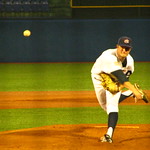
Photo by boomer-44 
The Yankees’ Gerrit Cole won his first four decisions in 2020 – giving him a 20-decision winning streak dating back to May of 2019. Then, on August 28, the Braves broke the streak – topping Cole and the Bronx Bombers 5-1 in Atlanta. (Notably, the pitcher who finally bested Cole, Ian Anderson, was making his first MLB appearance.)
Cole went on to lose his next two starts (to the Rays and Orioles) In those three consecutive losses, he surrendered 14 runs (ten earned) in 16 innings. He righted the ship thereafter, winning his next three decisions to finish the season 7-3, 2.84.
For more on Cole’s streak and other hurlers who won 20 or more consecutive decisions, click here.
We Do Like Round Numbers
Shane Bieber‘s 2020 season has been special – as he led all of MLB with 122 strikeouts (in 77 1/3 innings). He added a complementary touch to this performance on September 12, when he fanned eight batters in seven frames – despite taking the loss (3-1 to the Twins). Bieber fanned Twins’ C Ryan Jeffers in the fifth inning for his sixth strikeout of the game. It also was his 100th whiff of the season. He reached that round number in 62 2/3 innings – the fastest ever in a season by an MLB pitcher. His pace edged out Max Scherzer, who reached the 100K mark in 63 innings in 2018.
Look at Life from Both Sides Now … Or Not
On September 11, the Rays (often hailed for the innovative pitching strategies) put together a unique offensive lineup. Facing Red Sox righty Andrew Triggs, the Rays started (reportedly for the first time in modern base baseball – since 1900 – history) an all left-handed batting lineup. It went like this: Austin Meadows LF; Joey Wendle SS; Brandon Lowe 2B; Ji-Man Choi 1B; Kevin Kiermaier CF; Yoshi Tsutsugo 3B; Nate Lowe DH; Brett Phillips RF; Michael Perez C.
Despite the fact that no one in the lineup had an average over ,259 (seven of the nine were under .230), the port-sided Rays bashed 12 hits on their way to an 11-1 win. DH Nate Lowe, who came into the game with just one-hit in 14 at bats (.071 on the season) and no RBI, led the way going three-for-four with two home runs and four RBI. The Red Sox kind of played into the Rays’ strategy, they used six pitchers in the contest – five of them right-handed. Of note, is that fact that starter Triggs had actually looked pretty good against left handers (one-for-fourteen against him to that point in the season). Trigg left the contest after just one inning (neck issues). It should be noted that the Rays did score four of their runs off the only southpaw used by the Red Sox (Matt Hall) and that Hall (again the only southpaw used by the BoSox) took the loss.
No Run of the Mill(s) Start
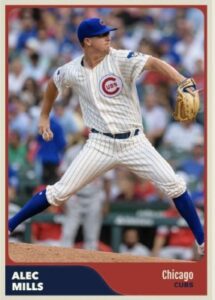 On September 13, Cubs’ 28-year-old righty Alec Mills picked up his sixth major-league win (15th career start and 29th MLB appearance – in four season). To that point in his career, he was 5-4 with a 4.19 earned run average. So, what did he do on the unlucky 13th? He threw the second 2020 no-hitter, shutting down the Brewers 12-0 in Milwaukee. In his nine-inning stint, Mills walked three and fanned five – throwing 114 pitches (74 for strikes). It was his first major-league complete game. Mills was a 22nd round draft pick (Royals) in 2012 – traded to the Cubs in 2017. In eight minor league seasons, he went 32-29, 3.69 – with one complete game in 115 starts.
On September 13, Cubs’ 28-year-old righty Alec Mills picked up his sixth major-league win (15th career start and 29th MLB appearance – in four season). To that point in his career, he was 5-4 with a 4.19 earned run average. So, what did he do on the unlucky 13th? He threw the second 2020 no-hitter, shutting down the Brewers 12-0 in Milwaukee. In his nine-inning stint, Mills walked three and fanned five – throwing 114 pitches (74 for strikes). It was his first major-league complete game. Mills was a 22nd round draft pick (Royals) in 2012 – traded to the Cubs in 2017. In eight minor league seasons, he went 32-29, 3.69 – with one complete game in 115 starts.
That Yankee Offense Goes Pretty Deep
From September 15 through September 17, the New York Yankees – in sweeping the Toronto Blue Jays – bashed a total of 19 home runs. That gave them a number of records including most home runs in a three-game series and most consecutive games with six or more home runs. Included in this run of long balls was a record-tying five home run inning (September 17). For more detail on this power outburst (and other five-homer frames), click here.
Gerrit Cole and a Nice Round Number
On September 16, as the Yankees routed the Blue Jays 13-2 in New York, Gerrit Cole notched his 100th career victory – Cole went seven innings, giving up one run and three hits, while walking two and fanning eight. The win came in Cole’s 203rd career start (eighth MLB season) and ran Cole’s career record to 100-55, 3.20, with 1,423 strikeouts in 1,261 innings pitched.
Plesac’s Immaculate Inning
On September 18, Indians’ starter Zach Plesac pitched 7 2/3 innings of scoreless ball (five hits, one walk and eleven strikeouts) as the Tribe defeated the Tigers 1-0 in Detroit. The highlight of Plesac’s fourth win of the season may have come in the second frame, when Plesac struck out Tigers’ LF Jorge Bonafacio, 2B Niko Goodrum and C Austine Romine on nine pitches – becoming the 93rd MLB pitcher to log an immaculate inning.
 A few other immaculate Inning tidbits.
A few other immaculate Inning tidbits.
- The Athletics’ Lefty Grove (1928) and Red Sox’ Chris Sale (2019) the only pitchers to throw two immaculate innings in one season.
- Nolan Ryan (Mets & Angels) is the only pitcher to throw an Immaculate Innings in both the NL and AL.
- The Royals’ Danny Jackson is the only pitcher to throw an Immaculate Inning in the World Series (Game 5, 1985).
Albert Pujols hit three home runs in September, giving him six on the season and 662 for his career – pulling him past William Mays (660) into fifth place all time. Next target for the 40-year-old Pujols? Alex Rodriguez (696).
Pulled While Throwing a No-Hitter … But No Surprise
On September 20, Dylan Cease started for the first-place Chicago White Sox against the Reds in Cincinnati. Cease came into the fourth inning having allowed no hits – and he did not give up a safety to any of the first three batters of the inning. Still, he was pulled, no-hitter intact. But it was no surprise. Cease had a 1-2-3 first inning., In the second frame, he gave up two walks and hit a batter (but held the Reds scoreless). He gave up two more walks, but no runs, in the third – and then walked the first three hitters in the fourth, before being replaced by Ross Detwiler. Cease’s final line was three innings pitched, no hits, five walks, one hit batsman, five strikeouts and three earned runs. Cease threw a total of 80 pitches – 43 balls and 37 strikes. The White Sox lost the game 7-3 and, in the process, walked 11 and hit three Reds’ batters.
Another Round Number
On September 20, Twins’ outfielder Max Kepler popped his eighth home run of the 2020 season – and the 100th of his MLB career. Kepler, in his sixth MLB season, increased his home run total each season from 2015-2019 … zero in 2015 (just seven at bats); 17 in 2016; 19 in 2017; 20 in 2018; 36 in 2019.
Big Day for a Big Guy
On September 21, as the Blue Jays topped the Yankees 11-5 in Toronto, 21-year-old Blue Jays’ rookie catcher Alejandro Kirk had a big day at the plate. Kirk came into the hitting .200 (two-for-ten in five games). In the September 21 contest, Kirk went four-for-four (his first MLB multi-hit game), scored three times, collected his first MLB extra base hit (a double) to lead off the fifth and added his first MLB home run and RBI (a solo shot leading off the seventh). Why the “Big Guy” in the headline. Kirk looks more like and NFL player than an MLB player … 5’8″, 265-pounds. The big guy has proven he can wield a big bat. In three minor league seasons (151 games), Kirk hit .315, with 17 home runs and 101 RBI.
Yadi’s Big Day – A Walk -Off Out of the Park
Yadiel Hernandez, a 32-year-old rookie for the Nationals, hit his first MLB home run on September 22 – and he made it count. It was a walk-off game-winner in the bottom of the eighth inning, in the second game of a double bill against the Phillies (in Washington D.C.). The 5’9′, 185-pound outfielder was signed by the Nationals after defecting from Cuba in 2015. He was a .324 hitter in six seasons in the Cuban National Series. in 2019, Hernandez hit .323-33-90 in 126 games for the Triple A Fresno Grizzlies.
Another Yadi’s Landmark
In the vein of round numbers, on September 24, Cardinals’ catcher Yadier Molina – a nine-time All Star, nine-time Gold Glover and .281 career hitter – slapped a single to shallow center in the seventh inning of the Cardinals’ 4-2 win over the Brewers. It was Molina’s 2,000 MLB hit (in 17 seasons, all for the Cardinals). The home town crowd would have gone wild. If there had been one.
Put a Flight Attendants on the One
On September 25, as the Braves topped the Red Sox 8-7 (11 innings) in Atlanta, still rising star Ronald Acuna, Jr, hit the longest home run (as measured by Statcast) of the 2020 season – a 495-footer off the Red Sox’ Chris Mazza to lead oft the bottom of the first. It was the 22-year-old’s 14th home run of the short season. In 2019, Acuna went .280-41-101 in 156 games and lead the National League with 37 stolen bases. Some of Acuna’s long-ball thunder may have been stolen on the 25th, as Braves’ 1B Freddie Freeman ended the contest with a walk-off home run to open the bottom of the 11th inning. It was Freeman’s 13th of the campaign.
Two Paths to that First MLB Hit
On September 26, two members of the Angels collected their first MLB base hits – both in their first MLB at bats; and in back-to back at bats. The similarities end there, as the pair took widely different paths to those first MLB safeties. It happened with one out in the top of the third. First, rookie second baseman Jahmai Jones single to center on the first MLB pitch he ever saw. Next up was rookie SS Elliot Sot0. Like Jones, it was Soto’s first MLB at bat. Soto, singled to right on the second MLB pitch he ever saw.
Those different paths to first base? Jones, a second-round pick in the 2015 draft) made the majors at age 23, in his sixth professional season. Soto was a “touch” senior, making his MLB debut at age 31. He was a 13th-round pick in the 2007 draft and was in his 11th pro season.
Double Your Pleasure, Double Your Fun

Photo by jenniferlinneaphotography 
When the scorebooks closed on the Yankees’ September 27 5-0 loss to the Marlins, New York’s DJ LeMahieu had logged a pair of singles – to finish the 2020 regular season with a .364 average. That made LeMahieu, who won the National League batting crown (.348) with the Rockies in 2016, the American League’s 2020 batting leader. It also made him the first player to win undisputed batting titles in both the AL and NL.
Saving the Best for Last
On the final day of the 2020 season (September 27), the Brewers turned 2020’s first triple play. It came in the bottom of the eighth of the Brew Crew’s 5-2 loss to the Cardinals. It was a “natural” around-the-horn triple-killing. The Cardinals’ Yadier Molina came up with runners on first and second. Molina grounded to Brewers’ third baseman Jace Peterson (who had made on error on the previous play to set up the triple play possibility). Peterson gloved the grounder and stepped on the bag for out number one and threw to second baseman Keston Huira for out number two. Huira then relayed the ball to first baseman Jedd Gyorko for the final out. One up, three down.
Power and Speed
On September 27, the Cubs’ Billy Hamilton surprised a lot of people – perhaps even himself. First, in the second inning of the Cubs’ game against the crosstown White Sox, Hamilton (after a walk and a single by Cameron Maybin) found himself on third base, one out and Maybin on first. Maybin took a long lead and made a move toward second while pitcher Carlos Rodon still had the ball. Rodon made a throw to first baseman Jose Abreu who threw to shortstop Tim Anderson covering – and Hamilton broke for home. Hamilton beat the throw from Anderson to the plate with a head first slide. Then in the fourth, Hamilton surprised, perhaps even himself, by popping a home run to left-center – his first round tripper since August 29, 2018. A steal of home and a home run – a surprising day.
——-Individual Statistical Leaders Final ———-
AVERAGE (qualifying, 3.1 plate appearances per team game played)
National League – Juan Soto, Nationals (.351); Freddie Freeman, Braves (.341); Marcell Ozuna, Braves (.338)
American League – DJ LeMahieu, Yankees (.364); Tim Anderson, White Sox (.322); David Fletcher, Angels (.319)
The lowest August average among qualifiers belonged to the Mariners’ Evan White at .176 (32-for-182). In the National League, it was the Cubs’ Kyle Schwarber at .188 (38-for-191). Others falling below the Mendoza line (under .200) included: Joey Gallo, Rangers (.181); Matt Olson, A’s (.195); Bryan Reynolds, Pirates (.189); Max Muncy, Dodgers (.192); Carlos Santana, Indians (.199)
HOME RUNS
National League – Marcell Ozuna, Braves (18); Fernando Tatis, Jr., Padres (17); Mookie Betts, Dodgers (16); Adam Duvall, Braves (16); Manny Machado, Padres (16); Kole Calhoun, Diamondbacks (16); Pete Alonso, Mets (16): AJ Pollock, Dodgers (17)
American League – Luke Voit, Yankees (22); Jose Abreu, White Sox (19); Jose Ramirez, Indians (17); Mike Trout Angels (17)
Reds’ OF Shogo Akiyama had the most 2020 at bats without a home run (155). Akiyama hit .245, scoring 16 runs and driving in nine (in 54 games played).
RUNS BATTED IN
National League – Marcell Ozuna, Braves (56); Freddie Freeman, Braves (53); Manny Machado, Padres (47)
American League – Jose Abreu, White Sox (60); Luke Voit, Yankees (52); Mike Trout, Angels (46); Jose Ramirez, Indians (46)
HITS
National League – Trea Turner, Nationals (78); Marcel Ozuna, Braves (77); Freddie Freeman, Braves (73)
American League – Jose Abreu, White Sox (76); DJ LeMahieu, Yankees (71); Whit Merrifield, Royals (70)
DOUBLES
National League – Freddie Freeman, Braves (23); Dominic Smith, Mets (21); Christian Walker, D-backs (18)
American League – Cesar Hernandez, Indians (20): Jose Iglesias, Orioles (17); five with 16
Freddie Freeman led MLB with 32 extra-base hits.
TRIPLES
National League – Trevor Story, Rockies (4); Mike Yastrzemski, Giants (4); Trea Turner, Nationals (4)
American League – Kyle Tucker, Astros (6); six with three
Juan Soto of the Nationals led qualifiers in slugging percentage .695. Jose Abreu of the White Sox topped the AL at .617.
STOLEN BASES
National League – Trevor Story, Rockies (15); Roman Quinn, Phillies (12); Trea Turner, Nationals, (12)
American League – Adalberto Mondesi, Royals (24); Manuel Margot, Rays (12); Dylan Moore, Mariners (12); Whit Merrifield, Royals (12)
Jonathan Villar stole the second most bases in MLB (16) – nine for the Marlins and seven for the Blue Jays.
WALKS
National League – Bryce Harper, Phillies (49 ); Christian Yelich, Brewers (46); Freddie Freeman, Braves (45)
American League – Carlos Santana, Indians (47); Cavan Biggio, Blue Jays (41); Aaron Hicks, Yankees (41)
The Nationals’ Juan Soto drew the most intentional walks with 12.
BATTER’S STRIKEOUTS
National League – Keston Hiura, Brewers (85); Christian Yelich, Brewers (76); Javier Baez, Cubs (75)
American League – Miguel Sano, Twins (90); Evan White, Mariners (84); Joey Gallo, Rangers (79)
A’s /Angels’ 2B Tommy La Stella had the best walks-to-strikeouts ratio at 2.25 (27 walks/12 strikeouts). By comparison, MLB whiff leader Miguel Sano (Twins) recorded 90 whiffs and just 18 walks (205 plate appearances.)
PITCHING VICTORIES
National League – Yu Darvish, Cubs (8-3); Max Fried, Braves (7-0); Zach Davies, Padres (7-4)
American League – Shane Bieber, Indians (8-1); Marco Gonzalez, Mariners (7-2); Gerrit Cole, Yankees (7-3)
The Diamondbacks’ Luke Weaver (1-9, 6.58) was the MLB leader in losses.
EARNED RUN AVERAGE (at least one inning pitched for reach team game played)
National League – Trevor Bauer, Reds (1.73); Yu Darvish, Cubs (2.01); Dinelson Lamet (2.09)
American League – Shane Bieber, Indians (1.63); Dallas Keuchel, White Sox (1.99): Chris Bassitt, A.s (2.29)
The Tigers’ Matt Boyd had the highest earned run average among pitchers with enough innings to qualify. He was 3-7, 6.71 in 12 starts.
STRIKEOUTS
National League – Jacob deGrom, Mets (104/68 IP); Trevor Bauer, Reds (100/73 IP); Aaron Nola, Phillies (96/71 1/3 IP)
American League – Shane Bieber, Indians (122/77 1/3 IP); Lucas Giolito, White Sox (97/72 1/3 IP); Gerrit Cole, Yankees (94/73 IP)
The leader in strikeouts per nine innings was the Indians’ Shame Bieber at 14.20. The Mets’ Jacob deGrom topped the NL at 13.76.
On the control side of the mound, the Cubs’ Kyle Hendricks walked the fewest batter per nine frames (0.89), with eight walks in 81 1/3 innings pitched. The only other qualifier under one walk per nine innings was the Mariners’ Marco Gonzalez at 0.90 (seven free passes n 69 2/3 innings).
COMPLETE GAMES
National League – Trevor Bauer, Reds (2); Adam Wainwright, Cardinals (2): Aaron Nola, Phillies (2)
American League – Gerrit Cole, Yankees (2); many with one
INNINGS PITCHED
National League – German Marquez, Rockies (81 2/3); Kyle Hendricks, Cubs (81 1/3); Yu Darvish, Cubs (76)
American League – Lance Lynn Rangers (84); Shane Bieber, Indians (77 1/3); Aaron Civale, Indians (74)
SAVES
National League – Josh Hader, Brewers (13); Brandon Kintzler, Marlins (12 ); Kenley Jansen, Dodgers (11); Mark Melancon, Braves (11)
American League – Brad Hand, Indians (16); Liam Hendriks, A’s (14); Alex Colome, White Sox (12); Ryan Pressley, Astros (12)
The Indians’ Brad Hand was a perfect 16-for-16 in save opportunities for the season.
————-Team Statistical Leaders Through August 31——————-
RUNS SCORED – Team Average … 278
National League – Dodgers (349); Braves (348); Padres (325)
American League – Yankees (315); White Sox (306); Blue Jays (302)
The Pirates and Rangers scored the fewest runs in 2020 – 219 and 224, respectively. To add some perspective, The Dodgers scored an average of 5.82 runs per game – the Pirates 3.65.
BATTING AVERAGE – Team Average … .245
National League – Mets (.272); Braves (.268); Nationals (.263)
American League – Red Sox (.265); White Sox (.261); Orioles (.258)
The lowest team batting average for the season was .212 for the Reds. The Ranger were at the bottom of the AL at .217.
ON-BASE PERCENTAGE – Team Average … .322
National League – Braves (.349); Mets (.348); Phillies (.342)
American League – Yankees (.342); Angels (.332); Red Sox (.330)
HOME RUNS – Team Average … 77
National League – Dodgers (118); Braves (103; Padres (95)
American League – White Sox (96); Yankees (94); Twins (91)
The Cardinals hit the fewest home runs (51) – averaging 0.87 per game. By comparison, the Dodgers averaged 1.97 per game.
SLUGGING PERCENTAGE – Team Average … .418
National League – Dodgers (.483); Braves (.483); Padres (.466)
American League – White Sox (.453); Yankees (.447); Red Sox (.445)
WALKS – Team Average … 203
National League – Braves (239); Reds (239); Phillies (229)
American League – Yankees (251); Rays (243); Angels (239); Indians (239)
Crowding the Plate
No team got plunked (HBP) more than the Cubs, who had 52 batters reach base via the Hit-By-Pitch. In the America League, the A’s led the way with 39 plunkings. The Rockies had the fewest hit batters (10), while the MLB team average was 27.
STOLEN BASES – Team Average … 29
National League – Padres (55); Marlins (51); Rockies (42)
American League – Mariners (50); Rangers (49); Royals (49)
The Twins stole the fewest bases (14) and made the fewest attempts (21). The average number of attempted steals was 39.
BATTER’S STRIKEOUTS – Team Average … 520
National League – Brewers (582); Braves (573); Cubs (568)
American League – Rays (608); White Sox (571); Tigers (567)
EARNED RUN AVERAGE – Team Average … 4.44
National League – Dodgers (3.02); Reds (3.84); Padres (3.86)
American League – Indians (3.29); Rays (3.56); Twins (3.58)
The highest 2020 ERA belonged to the Tigers at 5.63. The Rockies were the highest in the NL at 5.59.
STRIKEOUTS – Team Average … 520
National League – Reds (615); Brewers (614); Mets (574)
American League – Indians (621); Rays (552); Red Sox (537)
As noted earlier, Strikeout totals have been affected by games played (particularly with the COVID and civil protest postponements), as well as by seven-inning doubleheader games. So, let’s look at strikeouts per nine innings. Only four teams fanned at least ten batters per nine frames: Reds (11.o); Brewers (10.7); Indians (10.4); Mets (10.1). The MLB average was 9.1.
WALKS (Fewest) – Team Average … 203
National League – Dodgers (145); Padres (170); Cubs (182)
American League – Indians (157); A’s (165); Rays (168)
No team walked fewer hitters per nine innings than the Dodgers at 2.4. No team issued more free passes per nine frames than the Pirates at 4.4.
SAVES – Team Average … 14
National League – Marlins (18); Cubs (16); Rockies (16)
American League – Rays (23); Indians (20); Royals (19)
Primary Resources: MLB.com; Baseball-Reference.com; MLB.com; ESPN.com
 Baseball Roundtable is on the Feedspot list of the Top 100 Baseball Blogs. To see the full list, click here.
Baseball Roundtable is on the Feedspot list of the Top 100 Baseball Blogs. To see the full list, click here.
I tweet baseball @DavidBBRT
Follow/Like Baseball Roundtable’s Facebook Page here. More baseball commentary; blog post notifications; PRIZES.
Member: Society for American Baseball Research (SABR); The Baseball Reliquary; The Negro Leagues Baseball Museum.














